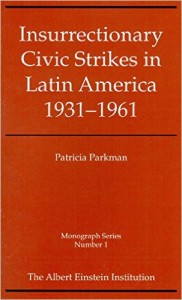Extrait de l’ouvrage: Patricia PARKMAN (1990), Insurrectionary Civic Strikes in Latin America 1931-1961, Monograph Series Number 1, The Albert Einstein Institute, Cambridge, MA; 55 p.
Pour consulter l’ouvrage complet, veuillez cliquer sur: Insurrectionary Civic Strikes in Latin America 1931-1961
 One of the characteristic features of the Latin American political landscape is a phenomenon best described as a civic strike: the collective suspension of normal activities by people of diverse social groups united by a common political objective? Latin Americans themselves have most often used the term « general strike » (huelgageneral, or grhe gidral in Haiti) to describe such actions, but this term, obviously borrowed from the labor movement, obscures the distinctive crossclass character of the civic strike. Civic strikes may be acts of protest, such as the shutdown of Managua, Nicaragua following the assassination of newspaper publisher Joaquin Charnorro in 1978, or they may serve as support for military movements against established governments, as in Venezuela in 1958 and Cuba in 1959? This paper considers the use of the civic strike as a nonmilitary insurrection by citizens who had no armed forces at their disposal.
One of the characteristic features of the Latin American political landscape is a phenomenon best described as a civic strike: the collective suspension of normal activities by people of diverse social groups united by a common political objective? Latin Americans themselves have most often used the term « general strike » (huelgageneral, or grhe gidral in Haiti) to describe such actions, but this term, obviously borrowed from the labor movement, obscures the distinctive crossclass character of the civic strike. Civic strikes may be acts of protest, such as the shutdown of Managua, Nicaragua following the assassination of newspaper publisher Joaquin Charnorro in 1978, or they may serve as support for military movements against established governments, as in Venezuela in 1958 and Cuba in 1959? This paper considers the use of the civic strike as a nonmilitary insurrection by citizens who had no armed forces at their disposal.
From 1931 to 1961 eleven Latin American presidents left office in the wake of civic strikes: Carlos IbAiiez del Camp of Chile (1931), Gerardo Machado of Cuba (1933), Maximiliano HernAndez Martinez of El Salvador (1944), Jorge Ubico of Guatemala (1944), Elie Lescot of Haiti (1946), Arnulfo Arias of Panama (1951), Paul Magloire, Joseph Nemours Pierre-Louis, and Frank Sylvain of Haiti (1956 and 1957), Gustavo Rojas Pinilla of Colombia (1957), and Joaquin Balaguer of the Dominican Republic (1962). In addition, at least four (an exhaustive search of available sources might reveal more) faced unsuccessful attempts to force them out by the same means: Juan de Dios Martinez Mera of Ecuador (19331, Carlos Mendieta of Cuba (1935), Tiburcio Carias Andino of Honduras (19441, and Anastasia Somoza Garcia of Nicaragua (1944).
A chronological summary of these events appears at the end of this essay. In the pages that follow, I will consider the context in which these civic strikes occurred and compare the social composition of the opposition movements, the leadership of and participation in the strikes themselves, and the use or non-use of violence by the insurgents. Finally, I will consider what factors accounted for the success or failure of these insurrectionary civic strikes.
